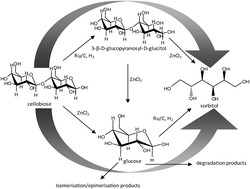Simultaneous hydrolysis and hydrogenation of cellobiose to sorbitol in molten salt hydrate media
Abstract
The

* Corresponding authors
a
Catalysis Engineering, ChemE, Delft University of Technology, Julianalaan 136, 2628 BL, Delft, The Netherlands
E-mail:
m.makkee@tudelft.nl
Fax: +31 15 278 5006
Tel: +31 15 278 1391
The

 Please wait while we load your content...
Something went wrong. Try again?
Please wait while we load your content...
Something went wrong. Try again?
J. Li, H. S. M. P. Soares, J. A. Moulijn and M. Makkee, Catal. Sci. Technol., 2013, 3, 1565 DOI: 10.1039/C3CY20808G
This article is licensed under a Creative Commons Attribution 3.0 Unported Licence. You can use material from this article in other publications without requesting further permissions from the RSC, provided that the correct acknowledgement is given.
Read more about how to correctly acknowledge RSC content.
 Fetching data from CrossRef.
Fetching data from CrossRef.
This may take some time to load.
Loading related content
